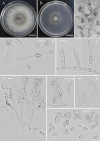Two new species of Nectriaceae (Hypocreales, Sordariomycetes) from Yunnan, China
- PMID: 39296988
- PMCID: PMC11408876
- DOI: 10.3897/mycokeys.108.130098
Two new species of Nectriaceae (Hypocreales, Sordariomycetes) from Yunnan, China
Abstract
Nectriaceae is a highly diverse family, and members have a worldwide distribution, particularly in warm temperate to tropical regions. During the survey of fungal diversity in different habitats in Yunnan province, China, two new species isolated from soil and air respectively, namely Atractiumyunnanense sp. nov. and Nalanthamalaxishuangbannaensis sp. nov., were proposed based on morphological comparisons and the multi-gene phylogenetic analyses of combined ITS, LSU, rpb2, and tub2 sequence data. Phylogenetically, both species clustered in a monophyletic clade within Nectriaceae with strong support. A.yunnanense is characterized by synnematous conidiophores, pale olivaceous-green, clavate to oblong-ellipsoidal, multi-septate conidia, and pale olivaceous-green chlamydospores. N.xishuangbannaensis has acremonium-like or penicillium-like conidiophores and either obovate or ellipsoidal, cylindrical or fusiform conidia. Full descriptions, illustrations, and a phylogenetic tree showing the phylogenetic position of the two new species were provided.
Keywords: Air-borne or soil-borne fungi; Hypocreales; fungal diversity; phylogeny; taxonomy.
Hua Zheng, Xinwen Dai, Haiyan Li, Zefen Yu.
Conflict of interest statement
The authors have declared that no competing interests exist.
Figures



Similar articles
-
Curvicladiellapaphiopedili sp. nov. (Hypocreales, Nectriaceae), a new species of orchid (Paphiopedilum sp.) from Guizhou, China.Biodivers Data J. 2022 Apr 5;10:e80122. doi: 10.3897/BDJ.10.e80122. eCollection 2022. Biodivers Data J. 2022. PMID: 35437398 Free PMC article.
-
Paramyrothecium eichhorniae sp. nov., Causing Leaf Blight Disease of Water Hyacinth from Thailand.Mycobiology. 2022 Feb 24;50(1):12-19. doi: 10.1080/12298093.2022.2027683. eCollection 2022. Mycobiology. 2022. PMID: 35291591 Free PMC article. Review.
-
Phylogenetic Insights Reveal New Taxa in Thyridariaceae and Massarinaceae.J Fungi (Basel). 2024 Aug 2;10(8):542. doi: 10.3390/jof10080542. J Fungi (Basel). 2024. PMID: 39194868 Free PMC article.
-
Morphological and molecular analyses reveal two new species of Microcera (Nectriaceae, Hypocreales) associated with scale insects on walnut in China.MycoKeys. 2023 May 29;98:19-35. doi: 10.3897/mycokeys.98.103484. eCollection 2023. MycoKeys. 2023. PMID: 37287767 Free PMC article.
-
Classification of the guava wilt fungus Myxosporium psidii, the palm pathogen Gliocladium vermoesenii and the persimmon wilt fungus Acremonium diospyri in Nalanthamala.Mycologia. 2005 Mar-Apr;97(2):375-95. doi: 10.3852/mycologia.97.2.375. Mycologia. 2005. PMID: 16396346
References
-
- Bao DF, Hyde KD, Maharachchikumbura SS, Perera RH, Thiyagaraja V, Hongsanan S, Wanasinghe DN, Shen H-W, Tian X-G, Yang L-Q, Nalumpang S, Luo Z-L. (2023) Taxonomy, phylogeny and evolution of freshwater Hypocreomycetidae (Sordariomycetes). Fungal Diversity 121(1): 1–94. 10.1007/s13225-023-00521-8 - DOI
-
- Chang DC, Grant GB, O’Donnell K, Wannemuehler KA, Noble-Wang J, Rao CY, Jacobson LM, Crowell CS, Sneed RS, Lewis FMT, Schaffzin JK, Kainer MA, Genese CA, Alfonso EC, Jones DB, Srinivasan A, Fridkin SK, Park BJ, Fusarium Keratitis Investigation Team (2006) Multistate outbreak of Fusariumkeratitis associated with use of a contact lens solution. Journal of the American Medical Association 296(8): 953–963. 10.1001/jama.296.8.953 - DOI - PubMed
-
- Crous PW, Osieck ER, Jurjević Ž, Boers J, Van Iperen A, Starink-Willemse M, Dima B, Balashov S, Bulgakov TS, Johnston PR, Morozova OV, Pinruan U, Sommai S, Alvarado P, Decock CA, Lebel T, McMullan-Fisher S, Moreno G, Shivas RG, Zhao L, Abdollahzadeh J, Abrinbana M, Ageev DV, Akhmetova G, Alexandrova AV, Altés A, Amaral AGG, Angelini C, Antonín V, Arenas F, Asselman P, Badali F, Baghela A, Bañares A, Barreto RW, Baseia IG, Bellanger J-M, Berraf-Tebbal A, Biketova A Yu, Bukharova NV, Burgess TI, Cabero J, Câmara MPS, Cano-Lira JF, Ceryngier P, Chávez R, Cowan DA, de Lima AF, Oliveira RL, Denman S, Dang QN, Dovana F, Duarte IG, Eichmeier A, Erhard A, Esteve-Raventós F, Fellin A, Ferisin G, Ferreira RJ, Ferrer A, Finy P, Gaya E, Geering ADW, Gil-Durán C, Glässnerová K, Glushakova AM, Gramaje D, Guard FE, Guarnizo AL, Haelewaters D, Halling RE, Hill R, Hirooka Y, Hubka V, Iliushin VA, Ivanova DD, Ivanushkina NE, Jangsantear P, Justo A, Kachalkin AV, Kato S, Khamsuntorn P, Kirtsideli IY, Knapp DG, Kochkina GA, Koukol O, Kovács GM, Kruse J, Kumar TKA, Kušan I, Læssøe T, Larsson E, Lebeuf R, Levicán G, Loizides M, Marinho P, Luangsa-ard JJ, Lukina EG, Magaña-Dueñas V, Maggs-Kölling G, Malysheva EF, Malysheva VF, Martín B, Martín MP, Matočec N, McTaggart AR, Mehrabi-Koushki M, Mešić A, Miller AN, Mironova P, Moreau P-A, Morte A, Müller K, Nagy LG, Nanu S, Navarro-Ródenas A, Nel WJ, Nguyen TH, Nóbrega TF, Noordeloos ME, Olariaga I, Overton BE, Ozerskaya SM, Palani P, Pancorbo F, Papp V, Pawłowska J, Pham TQ, Phosri C, Popov ES, Portugal A, Pošta A, Reschke K, Reul M, Ricci GM, Rodríguez A, Romanowski J, Ruchikachorn N, Saar I, Safi A, Sakolrak B, Salzmann F, Sandoval-Denis M, Sangwichein E, Sanhueza L, Sato T, Sastoque A, Senn-Irlet B, Shibata A, Siepe K, Somrithipol S, Spetik M, Sridhar P, Stchigel AM, Stuskova K, Suwannasai N, Tan YP, Thangavel R, Tiago I, Tiwari S, Tkalčec Z, Tomashevskaya MA, Tonegawa C, Tran HX, Tran NT, Trovão J, Trubitsyn VE, Van Wyk J, Vieira WAS, Vila J, Visagie CM, Vizzini A, Volobuev SV, Vu DT, Wangsawat N, Yaguchi T, Ercole E, Ferreira BW, de Souza AP, Vieira BS, Groenewald JZ. (2021) Fungal Planet description sheets: 1284–1382. Persoonia 47(1): 178–374. 10.3767/persoonia.2021.47.06 - DOI - PMC - PubMed
LinkOut - more resources
Full Text Sources
Research Materials
